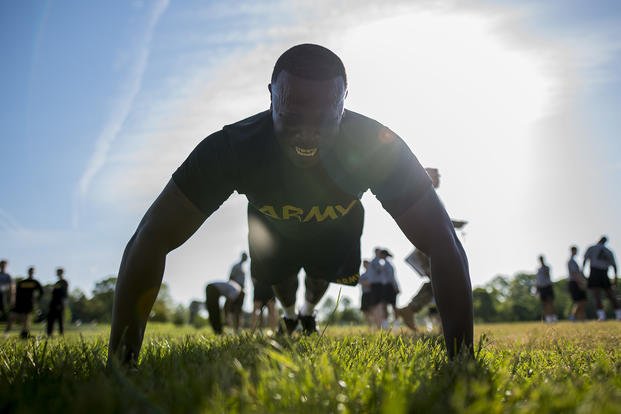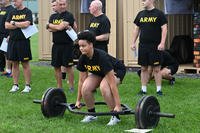Military, police and firefighter training programs require you to pass challenging physical standards. Often, law enforcement and firefighter professions are highly competitive as the city, stat, or county will have hundreds of candidates for a handful of openings.
This requires a better-than-average score to stand out in some fashion. Often the first time to put a good foot forward is a stellar fitness test. Here is a question from a future member of a tactical profession (applying to police and fire departments) who needs some assistance with PT programming.
Stew, I have been reading your Military.com articles for a while now and would like to ask you a few questions. I am mostly interested in increasing my pull-ups and push-ups. I watched Pull-up Push and the Push-up Push video for about 10 days (with three days rest/day 14 test) to do four times your max set, and plan to do this with my push-ups and pull-ups. I have watched your 0-20 pull-up video and have read your article. I am doing negatives and assisted pull-ups for the 10-day plan; is that OK? And I was wondering since I can't do an unassisted pull-up, how long should I expect to do one unassisted? Thanks again -- Mark
Mark, thanks for the note. It is obvious you have done your research on this topic, as all the links in your question give great details on how to start working to get better at the standard PT exercises like push-ups, pull-ups, even sit-ups.
Typical PT tests will require push-ups, sit-ups (sometimes pull-ups) and some type of run -- usually a 1.5-mile timed run. I call this the Most Common PT Test in the World. In fact, the PFT Bible is an ideal place to start, because it focuses on all of the above with various methods.
Methods of improvement
The push-up/pull-up push method is a two-week plan that requires you to do daily push-ups or pull-ups for 10 straight days. Then take three days to recover, avoid any pushing/pulling exercises and test on Day 14. Typically, people see a 50% to 100% increase in PT test performance, depending on what their scores were when they started.
However, if you cannot do any pull-ups, this is not the best plan to do, but you can try it with negative and assisted pull-ups if you want. It was not designed to get you to your first pull-up, but it may work if you try. Still, it is considered the overload principle with a recover cycle and test day.
PT Pyramids, Super Sets, Max Rep Sets -- These three are the classic trilogy of PT testing workouts and all can be done in the same week (every other day). Mixing in running every day is required, too, and this classic plan has this all rolled into it. Beginners will struggle with this one, but it is ideal for intermediate and advanced levels that want to push their max efforts on PT tests. When not just passing it is your goal and you want to crush it, this method is my favorite.
The first push-up/pull-up method: For true beginners who are struggling to do their first push-up or pull-up, it is all about gaining strength. While these strength testing exercises become muscle endurance exercises in fitness tests, your first few real repetitions still are pure strength. Mix in a variety of pull-up alternatives and related weight exercises in a "pull-up circuit."
Try this:
- Each set, always try a pull-up first, then resort to a negative pull-up by getting up to the bar by jumping or stepping on a chair. See whether you can control your descent to the down position for 4-5 seconds. If you can, try 2-3 repetitions. If you cannot, just hang there with shoulders flexed for as long as you can in the down position. The goal here is to get your arms used to supporting your body weight. If you are overweight, pull-ups naturally will be harder.
- Immediately after the hang or negative set, try a few jumping pull-ups to get yourself up to the bar and hang in the up position as long as you can.
- Resort to weights: Now, after the steps above, do heavy lat. Pulldowns for five reps, followed by rows or biceps curls (5-10 reps) to top off the pull-up/pulling set.
- Spend the next 4-5 minutes recovering with other exercises like push-ups, sit-ups or running -- active rest. Then repeat the above for 3-4 sets.
Eventually, the first pull-up will arrive. This is the hardest one to get typically, so be patient and do this program above every other day. After the first pull-ups, two, three and four are right around the corner by using the same method. Once you build up to five or more, start implementing the PT pyramid workouts and advance to the super sets and max-rep set challenges.
Stew Smith is a former Navy SEAL and fitness author certified as a Strength and Conditioning Specialist (CSCS) with the National Strength and Conditioning Association. Visit his Fitness eBook store if you're looking to start a workout program to create a healthy lifestyle. Send your fitness questions to stew@stewsmith.com.
Want to Learn More About Military Life?
Whether you're thinking of joining the military, looking for fitness and basic training tips, or keeping up with military life and benefits, Military.com has you covered. Subscribe to Military.com to have military news, updates and resources delivered directly to your inbox.


















